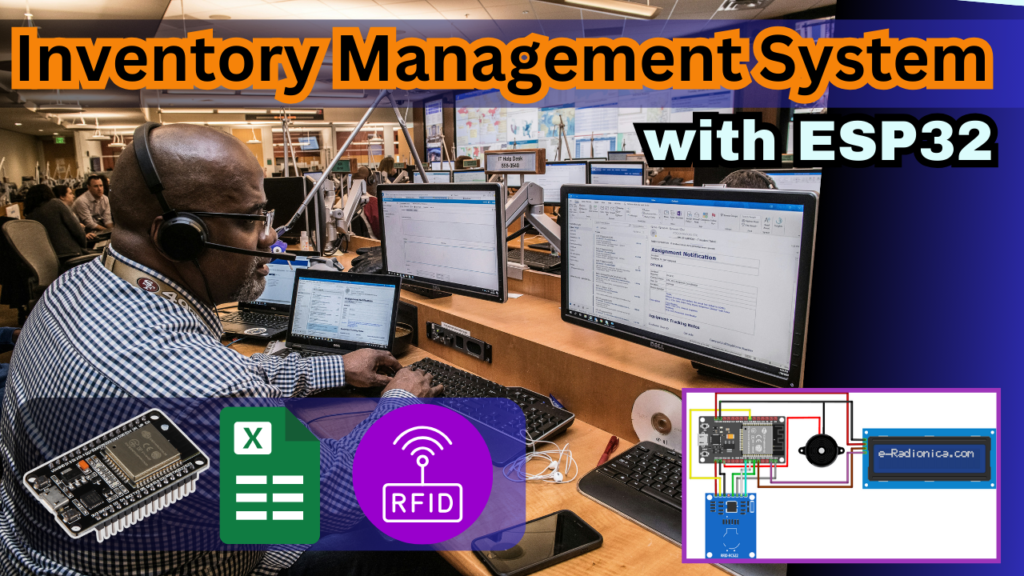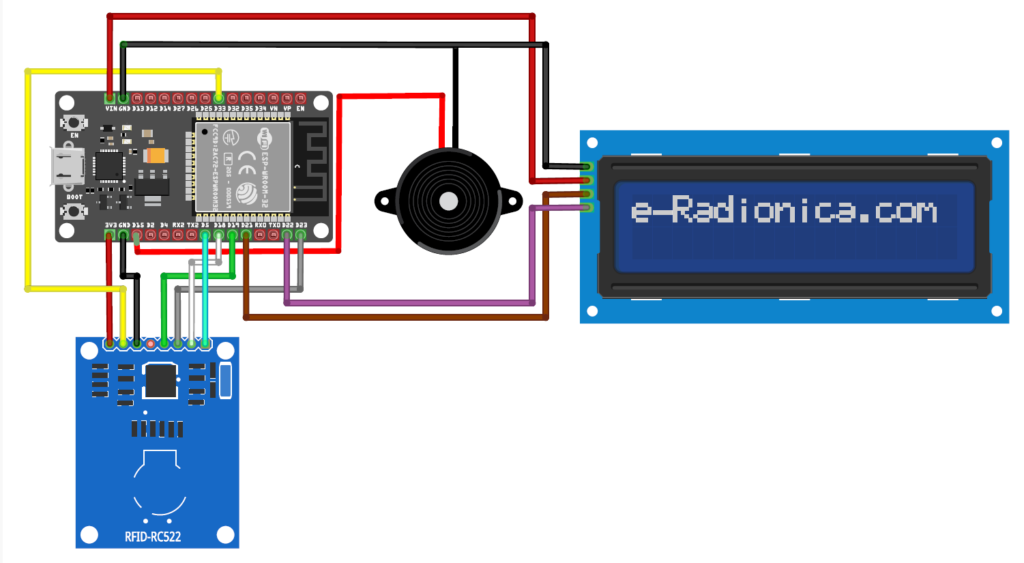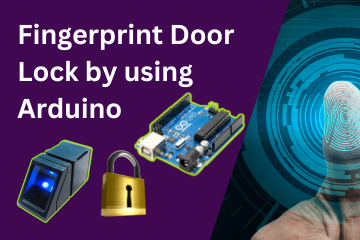This project is an IoT-based Inventory Management System that utilizes an ESP32, RFID module, buzzer, and Google Sheets for real-time tracking and logging of inventory items. The system allows users to scan RFID tags to check items in or out, providing a buzzer alert for successful or unauthorized scans. The data is stored in Google Sheets for easy access and management. Moreover, we can also use Excel or Specific Software or Platform instead of google Sheets for our project based user requirements.

Components used in Inventory Management System Project:
- ESP32 – Acts as the main microcontroller, handling communication between the RFID module, buzzer, and Google Sheets.
- RFID Module (RC522 or PN532) – Reads RFID tags to identify inventory items.
- RFID Tags – Unique identification cards/tags assigned to inventory items.
- Buzzer – Provides audio feedback for successful or failed scans.
- Google Sheets – Stores inventory records, including item ID, timestamp, and action (Check-in/Check-out).
- Wi-Fi Network – Enables ESP32 to communicate with Google Sheets via an API.
Features of Inventory Management System Project:
✅ RFID-Based Inventory Tracking
- Each inventory item is assigned a unique RFID tag.
- Users scan the tag to register a transaction (check-in/check-out).
✅ Real-Time Data Logging to Google Sheets
- The ESP32 sends data to Google Sheets using Google Apps Script (GAS) and Webhooks.
- The spreadsheet logs:
- Item ID
- Timestamp
- User ID (optional)
- Status (Checked-In / Checked-Out)
✅ Buzzer Alerts
- Success Alert: Short beep when an item is successfully checked in/out.
- Unauthorized Alert: Continuous beep for an unrecognized RFID tag.
✅ Internet-Based Access
- Inventory data is accessible from anywhere using Google Sheets.
- Multiple users can view or update data in real time.
✅ Security & Authentication
- Only pre-registered RFID tags are allowed.
- Unauthorized tags trigger an alert.
Working of Project:
User scans an RFID tag → The RFID module reads the unique ID.
ESP32 processes the ID → Checks if the tag is registered.
Data is sent to Google Sheets using an API call.
Google Sheets updates inventory logs in real time.
Buzzer gives feedback → Success or Unauthorized Access.
Circuit Diagram of Inventory Management System:

Code for Inventory Management System Project:
#include <MFRC522.h>
#include <SPI.h>
#include<WiFi.h>
#include <Wire.h>
#include <HTTPClient.h>
#include <LiquidCrystal_I2C.h>
LiquidCrystal_I2C lcd(0x27, 16, 2);
#define SS_PIN 5
#define RST_PIN 33
const char* NAME;
String res = "";
char* response = " ";
char* succ_code = "200 OK";
int buzz= 15;
MFRC522 mfrc522(SS_PIN, RST_PIN); // Create MFRC522 instance.
//Necessary parameters for IFTTT request
String Event_NAME = "Inventory Management";
String Key = "gY1JXdHkYiskNGkvu7mWkSDT6gZGR79CVbdTvLC93Ka";
String resource = "/trigger/" + Event_NAME + "/with/key/" + Key;
const char* server = "maker.ifttt.com";
// Provide your WiFi Credentials
const char* ssid = "Q G"; //Enter your wifi name
const char* password = "AlphaAli"; //Enter your wifi password
int count=0;
void setup()
{
Serial.begin(9600); // Initiate a serial communication
SPI.begin(); // Initiate SPI bus
lcd.init();
lcd.backlight();
mfrc522.PCD_Init(); // Initiate MFRC522
Serial.println("Approximate your card to the reader...");
Serial.println();
pinMode(buzz,OUTPUT);
initWiFi(); // Initialising WiFi connectivity if router is available
}Applications of Project:
This RFID-based Inventory Management System can be implemented in various sectors, such as:
1. Warehouse & Logistics Management
- Tracks incoming and outgoing inventory in real time.
- Prevents unauthorized access to restricted items.
- Reduces manual errors in stock management.
2. Retail Stores & Supermarkets
- Automates stock management and reduces checkout times.
- Helps prevent theft by monitoring unauthorized item removals.
3. Offices & Educational Institutions
- Monitors the issue and return of office supplies, books, or IT equipment.
- Maintains records of assets like laptops, projectors, and other electronic devices.
4. Hospitals & Pharmacies
- Tracks medical supplies, drugs, and equipment availability.
- Ensures timely restocking of essential medicines.
5. Manufacturing Industries
- Maintains records of raw materials, tools, and finished goods.
- Reduces loss of materials by keeping digital records of usage.
6. Hotels & Hospitality Industry
- Tracks the availability of items like towels, robes, and minibar stock.
- Prevents unauthorized removal of hotel assets.
7. Libraries & Bookstores
- Automates book borrowing and returning processes.
- Keeps real-time logs of issued books for easy tracking.
Conclusion:
The Inventory Management System using ESP32, RFID, Buzzer, and Google Sheets provides an efficient, low-cost, and real-time solution for tracking inventory. The integration of IoT technology with cloud-based Google Sheets ensures that the data is accessible from anywhere, making inventory tracking automated, secure, and paperless.
Need This Project?
If you need this Project with or without Modifications or Customization then you can contact us through WhatsApp. We can deliver you this Project in the Following Ways.
Project Code:
we can provide you Project Code along with Zoom Assistant, through Zoom meeting for Setup of this Project or any other Arduino Project of your need.
Fully Functional Project with Hardware/Components Shipment:
if you can not make this project yourself then you can use this option. We will assemble the Project and will ship it to your Doorstep with Safe Packaging.
Learn More about the services we offer.
How to make cost effective inventory management system?
you can make Inventory Management System by using ESP32, RFID module, buzzer, and Google Sheets for real-time tracking and logging of inventory items.




How it handles network downtime or security risks with multiple users accessing Google Sheets simultaneously